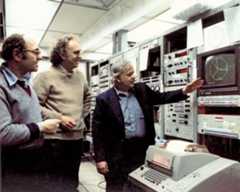Our editors will review what you’ve submitted and determine whether to revise the article.
Martin Lewis Perl
Martin Lewis Perl (born June 24, 1927, Brooklyn,New York, U.S.—died September 30, 2014,Palo Alto, California) was an American physicist who received the 1995Nobel Prize for Physics for discovering asubatomic particle that he named thetau, a massivelepton with a negativecharge. The tau, which he found in the mid-1970s, was the first evidence of a third “generation” of fundamental particles, the existence of which proved essential for completing the so-calledstandard model ofparticle physics. Perl was jointly awarded the Nobel Prize with physicistFrederick Reines, who had discovered another subatomic particle, theneutrino, in the 1950s.
In 1948 Perl graduated from the Polytechnic Institute of Brooklyn (now NYU Polytechnic School of Engineering) with a degree inchemical engineering. After working as a chemical engineer for two years, he studied nuclearphysics atColumbia University (Ph.D., 1955). He was an instructor and associate professor at theUniversity of Michigan (1955–63) before joining (1963) thefaculty ofStanford University, where he remained, becoming professor emeritus in 2004.
- Died:
- September 30, 2014,Palo Alto,California (aged 87)
- Awards And Honors:
- Nobel Prize (1995)
- Subjects Of Study:
- antitau
- subatomic particle
- tau
In 1966 Perl was part of a research team that made an unsuccessful attempt to discover new charged leptons by colliding electrons at theStanford Linear Accelerator Center (SLAC). A newparticle accelerator that began operation at SLAC in the early 1970s had the capacity to reach high energy levels that were previously inaccessible. With this new machine, Perl recorded frontal collisions between electrons and their antiparticles, positrons. In a series of experiments conducted between 1974 and 1977, he found that the collisions formed heavy leptons, later called tau particles, thatdecay in less than a trillionth of a second into neutrinos and either anelectron or amuon. He also discovered theantitau, which decays into neutrinos and either apositron or an antimuon. Despite his formal retirement from SLAC, Perl remained a collaborator there on numerous projects, which at the time of his death included one investigatingdark energy.





